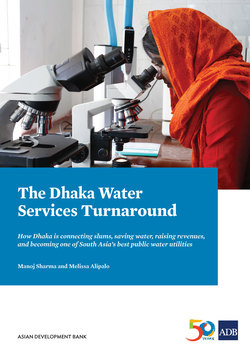Читать книгу The Dhaka Water Services Turnaround - Manoj Sharma - Страница 7
На сайте Литреса книга снята с продажи.
ОглавлениеTHE DHAKA TURNAROUND STORY
A Shining Example of South–South Learning
Since 2007, Dhaka’s water utility has been turning around its water services without leaving the poor behind. By creating closed hydrologic systems to break the megacity down into more serviceable and manageable zones, otherwise called “district metered areas (DMAs),” the utility has swiftly rehabilitated networks and connections, is now able to detect and reduce leaks, and delivers pressurized, clean water 24 hours a day to everyone, including the poor. The utility’s top management has also adroitly pushed through sensitive but essential reforms, and tested and validated its assumptions about the technical as well as financial viability of connecting slums. The Dhaka Water Supply and Sewerage Authority (DWASA) has thus become South Asia’s replicable model of an inclusive, enterprising, and commercially viable urban service utility.
A major reason for DWASA’s turnaround has been the $212.7 million Asian Development Bank (ADB)–financed Dhaka Water Supply Sector Development Program (DWSSDP), under a multi-donor partnership for the entire urban water sector in Bangladesh. The partnership combines sweeping yet pragmatic and phased reforms, innovative technology and management approaches, and a determination to connect slum areas.
What factors made DWASA’s turnaround possible? How did the utility navigate laws, policy, inertia, prejudice, and accustomed practice to get a megacity and its mega slums connected? More importantly, is DWASA’s success sustainable?
Cities across South Asia have begun turning to DWASA to learn about its technology and tactics, and replication is under way. “This is South–South learning at its best,” says Manoj Sharma, the ADB project manager who worked with DWASA for 6 years through its least hopeful to its shining moments. The multilateral development banks, including ADB, are also learning that investments in water distribution networks, and not only in bulk water supply, provide surety that the investments do not just speak for the poor but deliver the benefits of development dollars directly to them. Rather than simply pushing a loan condition, ADB took a more direct and proactive role in connecting urban poor households in Dhaka. Project designers cannot assume that networks will be extended to the poor. Design must be deliberate—not just “pro-poor” but for-the-poor design, implementation, monitoring, and evaluation.
Through the DWSSDP and a unique collaborative landscape of development partners working to support DWASA’s turnaround, DWASA is demonstrating how utilities can become government standard-bearers, both financially and in service to the public. Nongovernment organizations (NGOs) are finding their optimal role as facilitators rather than the small-scale development contractors that many have become, and the poor are proving to be a financially viable market that can also deliver their own development when basic social services are accessible. Once connected, communities invest in more durable housing, community assets, and sanitary environments. Pathways are paved; household and community toilets are built and maintained. Water inspires work. It encourages investments and construction, and sparks community pride.
Political and management commitment to connect the poor also begets new technical and management approaches. Legal work-arounds can sidestep prohibitions on connecting residents without land titles. Technical solutions can master even the most challenging urban terrain. Slums can, and must be, connected. To exclude them, to build systems exclusively for the politically, technically, and financially low-risk customer, incites the poor to rationalized theft to correct social injustice and inequality, causing its own set of technical and financial problems for utilities and privileged customers. Illegal connections—and in Dhaka’s case, the proliferation of suction pumps—can compromise the pressure and quality of water and its availability to all, and impair the performance of the larger system. Investing in systems for the poor is investing in systems for everyone.
The question for utilities is not why 24-hour water supply should be provided or why the poor should be connected. The advantages of 24-hour water supply compared with intermittent water supply are acknowledged by most top-level managers, who also know that access to clean drinking water and sanitation is a basic, universally declared human right.1 The question, rather, is how these seemingly formidable challenges can be surmounted, and everyone, including the poor, assured of 24-hour water supply, without exposing the utility (or its management) to political targeting or to further technical and financial strain. Taking such an obligation seriously is another matter, but one that concerns the most successful utilities as it has DWASA.
This publication tells Dhaka’s success story. It narrates how a nearly bankrupt, dysfunctional utility became one of South Asia’s leading public utilities, and how ADB and other partners helped make the turnaround possible, by daring to engage in development differently.
